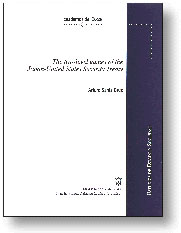| The two level-games of the Japan-United States Security Treaty
Arturo Santa Cruz
 Using Robert Putnam's Two Level-Games model, that offers a way for analyzing international negotiations in which the first level refers to bargaining among state's representatives to reach an agreement while at the second level, those same negotiators seek ratification from legislatures, bureaucracies and interest groups at the domestic level, Arturo Santa Cruz makes a detailed analysis of the negotiations leading to the 1952 and 1959 Japan-United States security treaties. By comparing the international context as well as the interplay of domestic and international factors during the negotiating process leading up to the treaties, the author shows why neither a purely domestic or a systemic account of this processes would be satisfactory. Focusing on the Japanese side of the negotiations, the author argues that Putnam's model is a valuable contribution for the understanding of the international political economy, even if it needs to be ammended in some respects. Using Robert Putnam's Two Level-Games model, that offers a way for analyzing international negotiations in which the first level refers to bargaining among state's representatives to reach an agreement while at the second level, those same negotiators seek ratification from legislatures, bureaucracies and interest groups at the domestic level, Arturo Santa Cruz makes a detailed analysis of the negotiations leading to the 1952 and 1959 Japan-United States security treaties. By comparing the international context as well as the interplay of domestic and international factors during the negotiating process leading up to the treaties, the author shows why neither a purely domestic or a systemic account of this processes would be satisfactory. Focusing on the Japanese side of the negotiations, the author argues that Putnam's model is a valuable contribution for the understanding of the international political economy, even if it needs to be ammended in some respects.
Índice /Introduction /The two-level games approach /The 1951 security treaty /The two-level games of the 1951 security treaty /The 1959 security treaty /The two level-games of the 1959 Security Treaty /Comparing the two-level games of the 1951 and 1959 security treaties and evaluating the two-level games model /Appendix /UdeG, 1998, 42 pp.
_______________________________________________________________

Coordinación de Tecnologías para el Aprendizaje
|

